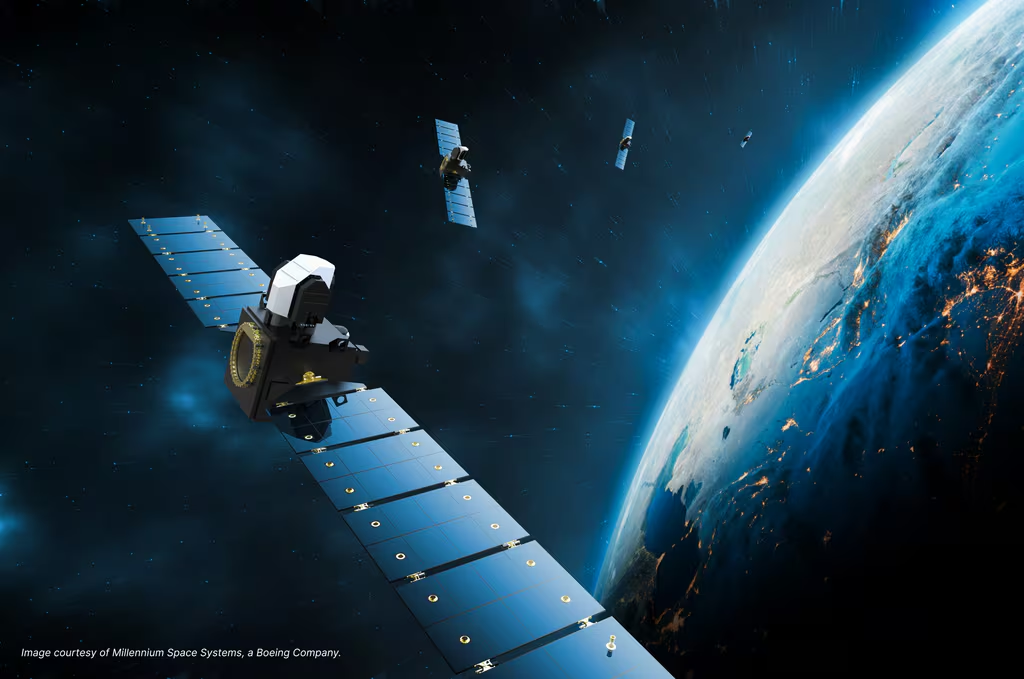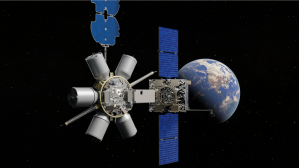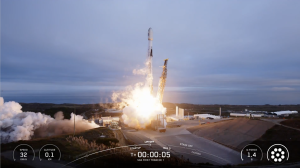Lockheed Martin readies next tech demo of space-based JADC2 capabilities

AURORA, Colo. — Lockheed Martin Space’s innovation unit has greenlit another mission to experiment with and demonstrate new technologies on orbit — this time focusing on tactical communications and artificial intelligence capabilities.
No sooner than March, the company will launch two small satellites into low-Earth orbit for its Pony Express 2 mission. Four Lockheed payloads will be integrated onto two space vehicles provided by Terrain Orbital and fly on a SpaceX mission Transporter-10 rideshare mission, with the payloads offering a tactical comms system; a Ka-band crosslink and mesh network; precision relative ranging and time synchronization across the satellites; and a high-end CPU/processor, according to a press release.
The mission is not attached to a specific Defense Department program, but instead is entirely self-funded by Lockheed Martin’s innovation unit, dubbed Ignite. By conducting experiments both on- and off-orbit, the organization is dedicated to accelerating space technology that could be leveraged by its government customers, according to Robert Lightfoot, executive vice president of Lockheed Martin Space.
“How do I infuse innovation? How do I advance technology faster than … the normal program of record or acquisition approach? And in doing so, how do I retire risk?” Lightfoot said in an interview with DefenseScoop at the annual AFA Warfare Symposium. “We had a bunch of innovation cells … but they were kind of pocketed. And so we put them into one organization called Ignite with the goal of doing demonstrations and prototypes for technologies we want to go deliver.”
A growing reliance on industry innovation is a theme that has become a mainstay at the Pentagon in recent years, especially as the commercial sector matures new technologies at a pace that historically does not line up with the traditional government acquisition cycle.
Rather than write a set of requirements for a new system and develop it through a contract, leaders at the Defense Department — and particularly in the Space Force — have emphasized that they want industry to take the lead on developing capabilities and showing the government what’s in the realm of the possible.
A “beta version” of Ignite was created in 2022, and the unit got its footing within the company at the end of 2023, Lightfoot said. The organization has already completed a handful of demonstrations and it has several other projects coming down the pipeline.
There currently is not a set goal for how many experiments Ignite wants to conduct per year. Rather, Lightfoot is encouraging the unit to “run with scissors” and show how existing space technology can close some of the Defense Department’s capability gaps, he said.
The upcoming mission is a follow-on to Pony Express 1, another self-funded demo launched in 2020 that tested Lockheed Martin’s AI and mesh networking in space. Pony Express 2 now looks to expand on those capabilities and showcase enhanced connectivity, payload adaptability and a slew of AI-enabled capabilities.
“On Pony Express 2 — it’s just a demo right? This is just two toaster-sized sats,” Lightfoot said. “But if I can prove this technology, … they can go on a big satellite, they can go on multiple satellites.”
Eventually, the spacecraft will be joined by others to build out Lockheed Martin’s Space-Augmented Joint All-Domain Operations Environment (SAJE), an on-orbit testbed dedicated to hosting tech that could contribute to the Pentagon-wide effort known as Joint All-Domain Command and Control (JADC2).
The warfighting concept seeks to provide commanders with the right decision-making data at a much faster pace than today’s architectures. The enabling technologies would connect platforms and weapons from all the services and key foreign partners across battlespace domains under a single network.
Lightfoot said Pony Express 2 will show “how space can be a part of the JADC2 discussion that you hear about all the time,” and look to prove that AI-enabled technology can be used to aid warfighters in decision-making as space-based capabilities become more crucial for the Defense Department’s missions.
“Instead of terabytes of data coming down to somebody on the ground, if we put some brains in there that everybody understands, we’re not taking humans out of the loop but we could do some processing before they get it. And then you give them what they really need,” he said.
Lockheed Martin’s HiveStar technology will underpin much of the capability demonstration for the upcoming mission. The “auctioneering system” can automatically distribute tasks across a constellation of systems with very minimal human intervention, according to the company’s website. The technology also enables mesh networking across multiple satellites, meaning that if one of the systems is degraded or destroyed the rest of the constellation will still be operational.
The payloads will also be equipped with Lockheed’s SmartSat capability, which permits applications to be uploaded onto the satellites once they’re already on orbit in order to enable edge processing of key data from space, Lightfoot said.
In addition, Ignite will show how the satellites can orbit together as a team using autonomy, and AI-enabled troubleshooting tech will be used to monitor the vehicles’ health and be able to predict possible failures, he noted.
Lightfoot emphasized that Pony Express 2 — as well as all of the self-funded experiments conducted by Ignite — are grounded in cues from the Defense Department and Lockheed Martin Space’s other government customers. In particular, there’s a need to better process and manage the increasing amounts of data that is coming from the space domain with as little human involvement as possible.
“What we have is a data-rich environment, and you have to have a way of managing that data,” Lightfoot said.
A key for the success of Pony Express 2 and other Ignite demonstrations will be having active participation from the Defense Department, Lightfoot said. After initial on-orbit demos, Pony Express 2 will be ready to participate in government exercises later this year.
“We would prefer to have them involved, and they have been involved, in what we’re doing,” he said. “Because if we’re going down this path and they say, ‘We really need you to go this way,’ we have time to adjust.”






